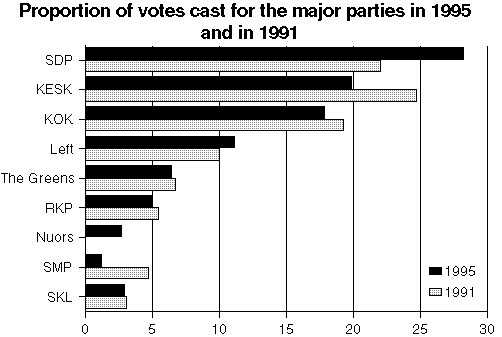|
|
|
Victory for the Social DemocratsThe Social Democratic Party emerged as the winner of the parliamentary elections, and re-established itself as Finland's largest party. The party got 28.3% of the given votes. The proportion of votes for the Social Democratic Party was 6.1% higher than in the previous parliamentary elections. The party now obtained its best result during the postwar era. As a total the Social Democtaric Party received 785 000 votes, almost 182 000 more than in 1991. In comparison to the previous elections the Social Democratic Party did especially well in the constituencies of Pohjois Karjala (+9.3%), Uusimaa (+8,8%), Mikkeli (+7.6%) and Kuopio (+7.2%). The Center Party obtained 19.9 % of the votes, losing in comparison to the previous parliamentary elections 5% of the votes cast . The total number of votes was 551 600, which is 125 000 votes less than in the previous elections. The Center Party's held its traditional regional support, the strong areas being the agrarian regions of Northern and Central Finland. The greatest drops in the proportion of votes cast since 1991 were in the constituencies of Lappi (-10.7%), Oulu (-8.0%), and Turku South(-7.9%). The party was best able to hold its stand in the constituencies of Häme North (-0.1%), Vaasa (-0.9%), and Turku North (-2.0). The National Coalition Party got 497 000 votes, 17.9% of all the votes. For the second parliamentary election in a row it lost support. The loss was now 1.4%. The proportions of votes cast for the National Coalition party decreased in all constituencies with the exception of Kymi, Turku South and Lappi. Especially it dropped in the party's strong areas: the constituencies of Häme North (-4.0%), Uusimaa (-4.0%), and Helsinki (-3.5%). The other winner of these elections was the Left Wing Alliance. The proportion of votes cast for the party was 1.1% higher than in the previous elections, giving it a support of 11.2%. There was no great change in the support of the other parties already in parliament. The Finnish Rural Party was an exception, as its support dropped by as much as 3.5%. The Progressive Finnish Party and the Ecological Party became new parties in parliament. The seats in parliament were divided among the parties as follows: the Social Democratic Party 63, the Center Party 44, the National Coalition Party 39, the Left Wing Alliance 22, the Swedish People's Party 11, the Green League 9, the Christian League of Finland 7, the Progressive Finnish Party 2, the Finnish Rural Party 1, and the Ecological Party 1. The Åland islands holds one seat.
The voting turnout on the same level as in 1991The turnout for Finnish citizens living in Finland was 71.8%. It was 0.3% lower than in the previous elections. In the large constituencies in the south, Helsinki, Uusimaa, and Turku South the voting turnout was higher, whereas it was lower in the rest of Finland and especially in Northern Finland.
|



